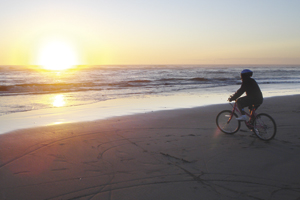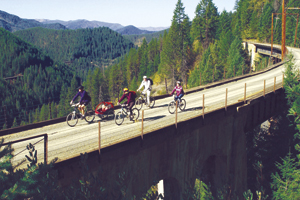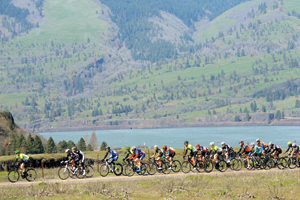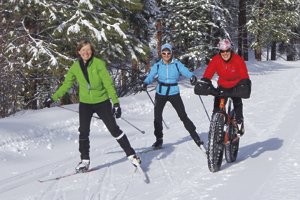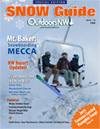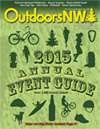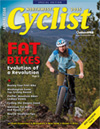Top 12 Northwest Travel Destinations

A Cure for Cabin Fever
See what our writers have for you for 2015!
Photo at right: A whale puts on a memorable show for ferry travelers in southeast Alaska. Photo by Ron Gile
Experience the Alaska Marine Highway
By Diane Rudholm
Don’t let the term “highway” fool you. While the Alaska Marine Highway is designated as an All-American Road, this 3,500-mile scenic route from Bellingham, Wash., to Dutch Harbor, Alaska, is meant for vehicles of the marine variety (though you can bring your car along for the ride).
Pitch a tent or reserve lodging on one of the 11 ferries for your journey. You can choose from more than 30 northern port destinations to explore, first traversing along beautiful Canadian coastline further north through the stunning islands of southeast Alaska, where you can view totem poles and learn about the culture of indigenous people.
And, if you continue north on the Alaska Marine Highway, you’ll have the option to check out Glacier Bay National Park. With its remarkable views and more than 720 miles of hiking trails, this is one gem that summer hikers won’t want to miss.
Or, if you opt to leave your trekking gear at home, stay on the ferry and continue along the route to one of the remaining ports in south-central or southwest Alaska.
Among the many notable stops along the way, you might recognize Kodiak Island, home of the Kodiak Brown Bear. Wave hello to the noble animals as you cruise by and, weather permitting, continue to the Aleutian Chain to take in the sights. We’re talking seals, walruses, birds, birds and more birds—and, of course, stunning volcanic terrain.
Resources
Alaska Marine Highway System: dot.state.ak.us/amhs
Bellingham-Alaska Ferry: www.ferryalaska.com
National Park Service: www.nps.gov
Tour Diablo Lake by Boat
By Diane Rudholm
We learn something new every day! Some days, more than others. When you join a Diablo Lake Boat Tour, you learn a whole lot about the rich natural history, biodiversity and geology of Washington’s Skagit Valley.
The day begins on the shore of Diablo Lake at the North Cascades Environmental Learning Center, where you’ll fuel up with a locally sourced, organic lunch.
Next is a guided tour on the boat docks, where the big topic of conversation is how the area’s three hydroelectric dams (Gorge, Diablo and Ross) connect to the environment and supplement power to Seattle, about 120 miles southwest.
Now that you’ve got the basics, it’s time to play on a boat. Hop aboard the Cascadian to cruise across the emerald green waters of Lake Diablo. There, your guides share stories about the area’s history, wildlife and environment – including a deeper discussion of the Skagit River Hydroelectric Project, which is how the local dams came to be.
Tours run from early July to mid-September, and have been going strong for more than 80 years.
Cost: General, $38; seniors, $35; youth ages 3 –12, $18; ages 2 and under, free
Resources
Diablo Lake Boat Tours: www.seattle.gov/light/tours/skagit/boat.asp
North Cascades Institute: www.ncascades.org
Yurt-Camp at Grayland Beach State Park
By Terri Stone
Want a great alternative to tent camping where you can stay warm and dry and still watch the Washington Coast waves come crashing in? Try the yurts at Grayland Beach State Park. They’re kid-friendly and a family favorite for us.
The 412-acre year-round marine park offers 16 yurts and 58 full hook-up campsites; bathrooms and showers are nearby. In our yurt, we liked the idea that if the weather was too damp (as the ocean can be sometimes), we could go back to our yurt, turn on the heat and play a game or read.
Our little bungalow came with a bunk bed (two on bottom, one on top), a futon that converted into a full size bed, and a small table/night stand.
Our favorite bike activities there included riding on the country roads around the cranberry bogs, and on the beach at sunset. The beach is great for kiting because it’s windy … all the time. That said, it’s not a very picnic-friendly beach, at least in our experience.
The nearby town of Westport (which observed its Centennial in 2014) is small, but its grocery store is stocked with everything you need, or forgot to pack.
Resources
Contact: (360) 267-4301/(888) 226-7688
Reservations: washington.goingtocamp.com/GraylandBeachStatePark?Map
Cost: Yurts run $59-89 per night, depending on the day and season.
Note: Some yurts are accessible to people with disabilities; pets are allowed in three selected yurts. A Discover Pass is required for vehicle access.
Grayland Beach: www.parks.wa.gov/515/Grayland-Beach
Grays Harbor Lighthouse: www.lighthousefriends.com/light.asp?id=117
Grays Harbor Tourism: www.visitgraysharbor.com
Westport/Grayland Chamber of Commerce: www.westportgrayland-chamber.org
Cat Ski in Nelson, B.C.
By Diane Rudholm
Cat skiing in Nelson, B.C. — 150 miles due north of Spokane, Wash. — has got to be one of the most enjoyable ways to experience the backcountry.
For one thing, your crew of up to 12 people ride up a mountain in a comfortable snow cat with professionals at the helm. For another, you average 12,000 to 20,000 vertical feet of skiing per day in the Nelson Kootenay Lake area, which offers an expansive 97,000 acres of terrain and averages more than 40 feet of snow annually.
There are five cat ski operations in the area, including Baldface, Selkirk Wilderness, White Grizzly, Retallack and Valhalla Powder Cats.
When you’re done for the day, there are a variety of great accommodations and fine dining establishments around Nelson, Ainsworth Hot Springs, Kaslo and Meadow Creek.
If you want to get a few ski days on the lift as a warmup for your backcountry adventure, you can always head to nearby Whitewater Ski Resort. Other must-try winter activities in Nelson include heli-skiing, Nordic skiing, outdoor and indoor skating, curling and hockey. If you’re heading to B.C. from Spokane, the Spokane Airport Shuttle offers daily service for $125 one way and $99 for return tickets.
Resources
Cat Ski Nelson Kootenay: www.nelsonkootenaylake.com/cat-ski-capital
Whitewater Ski Resort: www.skiwhitewater.com
Kootenay Shuttle: www.kootenayshuttle.com/spokane
Sojourn at a North Idaho B&B
By Diane Rudholm
Whether your summer plans are to explore the Kootenai National Wildlife Refuge, splash in the glittering waves of Lake Pend Oreille or experience the vastness of the Coeur d’Alene National Forest—there’s a cozy Bed and Breakfast within a stone’s throw.
Head to the North Idaho Bed & Breakfast Association’s website (www.nibba.com) to find a welcoming home away from home in the Idaho Panhandle.
Swim, Bike, Run
The region’s gorgeous glacial-created waterways and paths through scenic timberland are sure to make you want to swim, bike and run. Conveniently, you can do just that at the annual Coeur d’Alene IRONMAN Triathlon June 28. Spectators are encouraged to attend!
Hundreds of Miles of Trails
Biting at the bit to get out on the trails? Go on a family-friendly bike tour with Bicycle Adventures along the Trail of Coeur d’Alene, or plan your own tour through the railroad tunnel on the Route of the Hiawatha rail-trail. Whatever North Idaho destination catches your fancy, you have hundreds of miles of trails to choose from.
Resources
North Idaho Bed & Breakfast Association: www.nibba.com
Bicycle Adventures: www.bicycleadventures.com
Trail of Coeur d’Alene: www.friendsofcdatrails.org
Route of the Hiawatha: www.ridethehiawatha.com
Event
June 28: Coeur d’Alene IRONMAN, www.ironman.com
Play Year-Round in Ponderosa State Park
By Carolyn Price
Located in the shadow of Idaho’s Brundage Mountain, on the outskirts of the town of McCall, sits beautiful lake-side Ponderosa State Park.
Nordic skiers and snowshoers will find winter solace on snow-blanketed hills along the groomed trails adjacent to scenic Payette Lake, a popular winter and summer destination in south-central Idaho.
And, if you can’t make it this winter, Ponderosa offers a bonanza of summer fun!
With 12 miles of hiking and biking trails through more than 1,515 acres of land, this is a great camping spot to hike and bike with the family. The park, located on a peninsula extending out into the lake, offers 163 serviced campsites and five deluxe cabins (complete with Wi-Fi) for groups of all sizes. Rent a canoe or kayak, or just dive into the water for a refreshing swim on a hot day. The $10 daily Idaho State Park Passport gets you in. (Note: Campground is closed in the winter.)
And, adventurers beware! If you venture onto Payette Lake, pay heed to the mythical lake monster, Sharlie. According to local legend, Sharlie has been known to create whitecaps on the surface of the water, even on the calmest of days.
Besides oft-sighted but never photographed Sharlie, this area’s wildlife viewing opportunities are bountiful. Keep your eyes peeled for osprey, bald eagles, moose, bears and foxes.
Resources
Ponderosa State Park: www.parksandrecreation.idaho.gov/parks/ponderosa
Park Passes: www.parksandrecreation.idaho.gov/registration-renewals-permits-passes
Payette Lake: www.visitidaho.org/attraction/lakes-rivers/payette-lake
Cycle The Dalles, Oregon
By Diane Rudholm
If you’re looking for a bicycle adventure in a Mediterranean-esque climate but would prefer to stay close to home, consider touring The Dalles, located on the Oregon side of the Columbia River 85 miles east of Portland.
Located in a rain shadow, The Dalles offers road and trail cycling routes that are satisfying for casual tourists and experts alike — and, you can bring the whole family.
Road Riding
Plan a short out-and-back ride along the riverfront, or cycle a longer loop to see the most scenery for your mileage.
Cycle the River Front Trail for a flat 10-mile out-and-back excursion alongside the Columbia River to the Columbia Gorge Discovery Center.
The Cherry Heights Loop is 17.4 miles long and has an elevation gain of 1,800 feet. The route, which begins and ends at The Dalles’ Salmon Cyclery, winds through miles of cherry orchards.
For a more challenging ride with 3,760 feet of elevation gain, cruise from The Dalles to Hood River for an overnight stay, then return to The Dalles the next day for a roundtrip of 46.4 miles. For families, we’d recommend the car-free 17-mile stretch through the Twin Tunnels between Mosier and Hood River.
To see maps of these routes and others, go to: www.thedalleschamber.com/cycling_map.pdf
Mountain Biking
If the mountain biking bug has bitten you, drive about 55 miles southwest of The Dalles to Mt. Hood to play on miles of outstanding single-track with views of Mt. Adams and Mt. St. Helens.
Resources
Ride Oregon Ride: www.rideoregonride.com
Salmon Cyclery: www.salmoncyclery.com
Columbia Gorge Discovery Center: www.gorgediscovery.org
Mt. Hood Singletrack Trails: www.cascadesingletrack.com
Event
March 28–29: Gorge Roubaix, The Dalles, OR: www.gorgeroubaix.com
Explore Historic Thurston County
By Rebecca Agiewich
Home to Washington’s capitol city of Olympia, Thurston County brims with year-round activities for the adventurous visitor — from waterfall walks to scenic rail trails. Here are a few adventures to check out on your next visit.
Nisqually Wildlife Refuge
The Nisqually River Delta is a wildlife-rich area at the southern end of Puget Sound that supports salt marsh, freshwater marsh and a variety of other wildlife-rich habitat.
Thanks to the Nisqually Wildlife Refuge, an abundance of bird and marine life thrives here. Kayakers, hikers, and birdwatchers can enjoy eagles, geese, sandpipers, warblers, thrushes and many other bird species.
A mile-long boardwalk (completed in 2011) takes visitors out onto the delta for close-up views, and also offers panoramas of Mount Rainier, the Olympics and Puget Sound.
Chehalis Western Trail
Washington boasts more rail-trails than any other state in the west, and the Chehalis Western trail is one of the sparkling jewels in its crown. Stretching for 22 miles through the heart of Thurston County, it links up with the Yelm-Tenino Trail, passing through wetlands, farmland and prairie along the way. It also includes two miles of frontage along the Deschutes River, where you might see waterfowl, beaver and deer.
Tumwater Falls Park
Amble among cascading waterfalls, reflective pools and massive boulders at the scenic Tumwater Falls State Park, where the Deschutes River tumbles 82 feet into Capitol Lake, at the most southern-most part of Puget Sound.
Located in the historic city of Tumwater, this 15-acre park offers walking trails, play areas and picnic facilities. Be sure to check out the fish ladder in fall, where spawning salmon make their way home.
Interesting fact: Tumwater is the oldest permanent American settlement on Puget Sound and is known as the end of the Oregon, or Cowlitz, Trail.
Resources
Nisqually Wildlife Refuge: www.fws.gov/refuge/Nisqually
Visit Olympia: www.visitolympia.com
Kayak Oregon’s Tillamook Coast
By Rebecca Agiewich
The Tillamook coast of northern Oregon encompasses 62 scenic miles of gorgeous beaches, historic lighthouses and vertiginous waterfalls. To the delight of paddlers, it also boasts five wildlife-rich estuaries and year-round kayaking tours (thanks to local outfitter Kayak Tillamook). The list below offers paddling suggestions for every season.
Winter: Hoquarton Forest
Paddling the coastal bays and main rivers of the Tillamook coast be challenging in winter, so heading inland to the Hoquarton Forest is a safer choice. Here, a tidal slough meanders through an old-growth forest of Sitka Spruce, making for a serene winter paddle with glimpses of red-tailed hawks, otters, and more. Bonus: Get a steaming thermos of hot apple cider when you take this tour with Kayak Tillamook in winter.
Spring: Nehalem River
Paddle the Nehalem River during the spring salmon runs and watch the harbor seals swim upriver to catch the salmon. Eagles often congregate in nearby trees waiting for their chance to get in on the action.
Summer: Three Graces
Named after three striking stone outcroppings, this destination is close to the mouth of Tillamook Bay. This means you can take advantage of summer’s low-volume tidal exchanges to safely visit these rocky sculptures encrusted with a colorful array of marine life.
Fall: Nestucca Bay
In the fall, the coastal winds calm down, making it easier to venture out into coastal bays. Harbor seals, Dungeness crab, and a variety of jellyfish are just a few of the creatures that populate this bay at the confluence of the Little Nestucca and Nestucca Rivers.
Resource
Kayak Tillamook: www.kayaktillamook.com
More than Wine in Walla Walla
By Diane Rudholm
Walla Walla, located in southeastern Washington (273 miles from Seattle) near the Oregon border, may be known for its 100-plus wineries, but it’s also a wintry gateway to the classic snow-play opportunities you love: downhill and cross-country skiing, snowboarding and snowshoeing.
Use Walla Walla as your home base for winter wine tastings and “February is for Foodies” events, and then spend some time playing in the snow.
Ski Bluewood, just 53 miles east of Walla Walla and offering the second highest base elevation in the state (5,670 feet), features more than 400 acres of lift-serviced terrain.
Or, head 41 miles southeast, across the Washington-Oregon border, to Spout Springs Ski Area in the Umatilla National Forest. This family-owned gem offers downhill and cross-country trails.
Summer Cycling
When the snow melts, Walla Walla Valley’s road cycling scene comes alive. Take a gander at the Walla Walla Valley Bicycle Map, and dream up a route that’s just right for you. Cruise through downtown for a quick ride or make your way along dozens of miles of rural, rolling hills and quiet countryside.
Then, rest up and sip some wine! You’re in Walla Walla, after all.
Bonus: Tour Tri-Cities
Can’t get enough of Washington wines? The Tri-Cities area, just an hour west of Walla Walla, offers other fabulous snow-sport, wine and cycling options. It’s also just a hop, skip and a jump from Hanford Reach—a scenic desert hike that’s ideal in summer months.
Resources
Walla Walla Tourism: www.wallawalla.org
Ski Bluewood: www.bluewood.com
Spout Springs Ski Area: www.spoutspringsskiarea.com
Walla Walla Valley Bicycle Map: www.wallawalla.org/assets//BikeRidesArea.pdf
Walla Walla Valley Cycling: www.wwvalleycycling.com
City of Walla Walla: www.ci.walla-walla.wa.us
Visit Tri-Cities: www.visittri-cities.com
Hike Hanford Reach: www.bit.ly/onwHanfordReach
Events
Feb. 1–28: February is for Foodies, www.wallawalla.org
April 18–20: Tour of Walla Walla, www.tofww.org
Snow-play in the Yakima Valley
By Rebecca Agiewich
With 300 days of sunshine a year, the Yakima Valley in central Washington is a great place to recreate year-round. In spring and summer, you can hike, bike and raft. And when snow blankets the eastern Cascades, you can explore it in a variety of ways. Here are a few ideas for your winter adventures.
White Pass Ski Area
Located just 50 miles west of Yakima, White Pass offers dedicated downhill and Nordic skiing, as well as backcountry skiing in the surrounding mountains. The White Pass Winter Carnival (Feb. 28 – March 1) features a huge snow castle, professional snow sculptors from around the Northwest, and fun snow-sport competitions for both kids and adults.
Of particular interest, 1984 Olympic medalist twins Steve and Phil Mahre honed their skills at White Pass.
Union Gap Snowmobiling
Love snowmobiling? There’s lots of it here, with numerous trails along the White Pass Scenic Byway and in the Ahtanum Meadows and Ahtanum Guard Station area. Motels in the town of Union Gap offer snowmobiling packages throughout the winter, including the Super 8, the Best Western Plus, and the Quality Inn.
Oak Creek Wildlife Viewing
Snow sports aren’t the only way to enjoy winter in the Yakima Valley. For a unique experience, take the whole family to see Rocky Mountain Elk at the Oak Creek Wildlife Feeding Station.
Hundreds of elk come daily to the feeding site, where you can experience their majesty in a safe and peaceful setting. See the elk either via a free 30-minute truck tour (donations are suggested) — which allows for great photo ops — or from an indoor viewing area.
Reservations are recommended for the tour and can be made by contacting the Oak Creek Wildlife Area at (509) 653-2390.
Resources
White Pass: www.skiwhitepass.com
Yakima Valley Tourism: www.yakimavalleytourism.com
Oak Creek Wildlife Area: wdfw.wa.gov/lands/wildlife_areas/oak_creek
Event
Feb. 28–March 1: White Pass Winter Carnival, www.skiwhitepass.com
Nordic Ski the Methow Trails
By Michael Fagin
If you Nordic ski in the Northwest you have to check out the Methow Trails, which make up the nation’s largest cross-country ski area. Located in north-central Washington near the Western-themed town of Winthrop, this trail system offers more than 120 miles of groomed trails through scenic forest and farmland.
There are trails for classic cross-country skiers, skate skiers and snowshoers. There are also several designated trails open for skiers with dogs (for an extra fee).
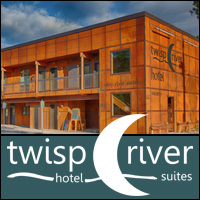 Lodging
Lodging
My wife’s favorite part of coming to the Methow Valley is selecting a rental cabin next to the trails so we can go for an early-morning ski and return to the cabin for coffee and breakfast.
A stay at one of the five Rendezvous Huts — located along the Methow Trails for hut-to-hut ski adventuring — is another popular lodging option among local and visiting Nordic skiers. Dogs are allowed at three of the huts (Grizzly, Heifer and Rendezvous) in the winter. Weekend reservations for the huts fill up fast, so you’ll want to plan ahead.
Best Time to Go
February and March are usually sunny, with longer days and much warmer temperatures than earlier in the winter. However, do not wait too long to visit. After April the snow tends to melt out quickly. But then again, we’ll be back for all the awesome mountain biking come summer—along the same trails!
Resources
Methow Trails: www.methowtrails.org
Winthrop Chamber of Commerce: www.winthropwashington.com
Rendezvous Huts: www.rendezvoushuts.com

